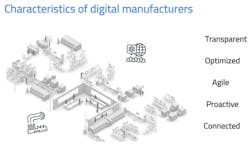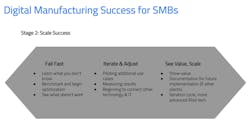Static Manufacturing Can’t Exist in a Dynamic World, Part 2
In Part 1 we discussed how engineers improve processes, and how new technology can fall short of manual operations. The importance of dynamic, flexible solutions was stressed as the only way process engineers on the front line will be able to continuously improve factory performance to maintain a competitive edge. In this installment, we present common challenges across different industries, how tech enables us to manage complexity, and what is needed in the tools of tomorrow.
Manufacturing is in the midst of a period of unprecedented change. The manufacturers that will prove best able to capture new value amid this change will be those who can best embrace flexibility and best manage complexity. A new layer of manufacturing software is beginning to emerge to answer this call. This layer of tech is just beginning to take shape; however, certain qualities have already been identified as indispensable. The following series will consider the needs modern manufacturers are facing and the role of software in answering these needs. Drawing from multiple manufacturing operations including small, medium, and Fortune 500 companies, this article will evaluate the effectiveness of available technologies and comment on promising trends. Ultimately, this series will conclude that modern consumer web tech can be leveraged to guide, track, and continuously improve modern manufacturing operations.
Common Challenges Across Different Industries
During this inquiry, more than a dozen front-line engineers, operators, and senior managers from different-sized companies were consulted. These manufacturers come from a variety of verticals, including apparel, contract manufacturing, aerospace and defense, medical device, biopharma, and firearms manufacturing. All interviews were conducted under nondisclosure agreements and so specific names and industry specific challenges remain confidential. However, the challenges they encountered were the same regardless of the size of operation or industry vertical. Manufacturers don’t need a perfect software solution to a static system. They need a flexible solution that embraces change and enables manufactures to manage complexity.
One up-and-coming process engineer interviewed from a leading firearms manufacturer described having to scale the production of a given line from 250 units per day to more than 4,000 per day in less than 12 months. To accomplish this feat, the process engineer had to iterate on his process daily. He knew he did have time to find the optimal solution. There were too many unknowns and the system was too complicated.
The process engineer adapted a strategy of rapid experimentation. He regularly made incremental adjustments, monitored the impact on production, and then adjusted his plan accordingly. Attempting to achieve this sort of production gain using the bespoken MES was impossible. The turnaround time between identifying needs and adjusting the MES software accordingly could take months. Yet, he had to demonstrate double-digit production gains each week while relying on the existing resources.
When faced with the decision of how to track the impact a particular adjustment would have on production his only option was to print some forms to record defects and then stand by with a stopwatch to measure how much time the adjustment saved per product produced. These manual tools are time-intensive, incomplete, inefficient, and error-prone. Even so, they are consistently used as workarounds to the existing software solutions because they offer more flexibility than some MESs. Manual tools can be modified and repurposed by the front-line engineers tasked with solving these problems in just a few minutes.
Tech Enables Us to Manage Complexity
Long gone are the times when a lone engineer could conceptualize and optimize an entire manufacturing value chain. Dynamic demands, striving for increasingly efficient operations, and deciding which resources merit investment from among the myriad of options necessitate a new generation of tools.
We’ve seen this before: This happened with the personal computer three decades ago. The set of capabilities made available by the computer grew to a point where a layer of technology was necessary to simply enable a user to navigate the complexity to make use of the newly available tools. We called it an operating system, and it now defines most user’s experience with a computer. Manufacturing is reaching a similar point and a comparable solution is necessary.
Tomorrow’s Tools
This new layer of technology that will transform manufacturing is just beginning to take form. While its final form is still unclear, certain key attributes are beginning to emerge as crucial to its success. The software must enable those closest to the problems, the front-line engineers, to directly engage with and modify the software’s applications to suit their needs. Engineers need to be able to experiment within these applications and adapt their approach to process design based upon real-time feedback loops. Basic logic must be made available to the front-line engineers. This means that the software must have a simple-yet-powerful visual programming capability. The software must also be able to incorporate sensor and machine data streams. It must both capture this data for analysis in a common software environment and make the data available to trigger actions within the application.
Again, this must be made available without the need to do any coding. Furthermore, this new layer of technology must be managed and deployed in a distributed manner using a common user interface and protocols. It must provide real time feedback loops both to the engineer creating and deploying the application and other engineers working on parallel interdependent systems. This new layer of tech must operate in real-time without the concern of version control, which means the software must be web native. It must tie into and make accessible existing siloed data and control capabilities such as quality management systems, performance metrics, and guide-standard work. First, this layer of tech must work with existing software systems already in operation. However, this new layer of software will ultimately supplant custom-coded centrally administered systems.
Conclusion
Today, new technology is being introduced to manufacturers faster than ever, and the rate is still accelerating. Technology such as:
- Robotics
- Additive manufacturing
- Automation
- Dynamic scheduling
- Computer vision systems
- Smart devices
- Connected machines
These are just a few of the capabilities that have become commonplace. The availability and adoption of new technology is exponentially increasing the complexity of these operations. This complexity needs to be managed to inform decision-making.
Manufacturing demands are driving the need for a new layer of tech to connect the manufacturing operation, manage the complexity, and provide front-line engineers flexibility. While the form of this layer of software is just starting to take shape, certain key attributes are already identifiable. This new layer of tech must give front-line engineers the ability to quickly design and deploy custom software applications to various endpoints on the shop floor. It must tie into pre-existing but siloed legacy systems. It must connect existing machines and sensors within the manufacturing environment and make their data streams available within the application creation environment.
Manufacturing is in the midst of unprecedented change. Those manufacturers that are going to be best able to capture the value made available through this change will be those who can best embrace flexibility and best manage complexity.
Erik Mirandette is head of customer operations at Tulip.




